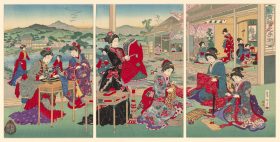Image: LINK Dance Company. Supplied.
The image of the academic ivory tower has been particularly problematic for the arts to overcome. Without a clear correlation between theory and practical output, too often people are left asking, what’s the point? But the completion of a carefully researched higher degree can empower artists, pushing art forms in unheard-of directions and creating a valuable space for the creation of new work.
It can also, given the right context, be a space where new technological innovations can cross-fertilise with creative practice.
The latter is the case for Dr Luke Hopper, a Lecturer and Postdoctoral Research Fellow at the Western Australian Academy of Performing Arts (WAAPA).
Hopper’s first academic position didn’t include access to a laboratory, but that changed when he joined WAAPA. ‘I was approached by ECU eResearch coordinator Heather Boyd who said she was looking at motion capture on campus at Mount Lawley and I just jumped at the chance to have the lab and access to the dancers in the one space. That is really valuable,’ he said.
With access to professional dancers studying at the university and a well-equipped research space, Hopper’s work in biomechanics, dance health and wellness can continue to break new ground. His research will lead to innovations in the way professional dancers train and will also assist with injury prevention.
‘In my area in particular, there are quite a lot of dancers who, because they finish their careers so early, go on to physiotherapy, psychology or medicine, and then end up coming back to work with dancers from a [health or rehabilitation] angle.
‘From that side of things, there is real value in doing higher degree research and specialising in the field,’ he said.
At WAAPA, practice is at the centre of postgraduate research. This practice-led approach means that the techniques familiar to artists through their work are applied to a set of research questions that can either extend one’s practice or potentially lead to new discoveries about it. ‘Often that is about creating new work as well,’ said Dr Renee Newman, Lecturer at WAAPA.
‘What [higher degree by research] offers is the capacity to find new ways of saying and doing things surrounding the arts and contributing to scholarship as a result.
‘Our students are contributing academically to how we talk about art and the relationship of art to the rest of the world. That is very attractive to practitioners,’ she said.
WAAPA successfully creates opportunities for Masters and PhD students to collaborate with other emerging professionals in their field who make up the performance groups and ensembles within the academy – including LINK Dance Company and new music ensemble, Decibel.
‘Recently we began to encourage people to come to us to talk about their dance practice as a choreographer, for example, and to work alongside LINK, which is our fourth year Honours program and operates as a pre-professional training ground,’ said Newman.
‘We have one Masters candidate who is a choreographer and dancer. She is working with LINK as a dancer and [potentially] with the company to develop her research project, if that is how her project manifests.’
SKINLESS by Carmelo Segura for LINK DANCE COMPANY, Australia from Carmelo Segura Companhia on Vimeo.
These collaborative opportunities exist as a way to support both programs. ‘It is really exciting to see that play out,’ Newman added.
If you’re interested in postgraduate studies at WAAPA, visit http://www.waapa.ecu.edu.au/research-and-creative-activity/overview





